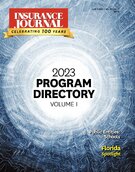How could the current economic environment affect workers’ compensation — and the property and casualty insurance industry overall – in 2023?
That’s a question that insurance veteran Robert Hartwig addressed in a recent presentation. Hartwig, a clinical associate professor of finance and insurance at the University of South Carolina’s Darla Moore School of Business, laid out his predictions at the NCCI Annual Insights Symposium in Orlando, Florida.
Despite banking and national budget debacles, financial market volatility and a mild recession likely looming, Hartwig’s prognostication was largely optimistic.
“The P&C insurance industry is strong, stable, sound and secure,” he said.
Economic Overview
At last year’s Annual Insights Symposium (AIS) conference, Hartwig told attendees the U.S. was not and would not enter a recession in 2022. That proved true. At the same time, however, consumer sentiment is still relatively low today.
“It’s near 20-year lows,” Hartwig explained, “although it’s come up a little bit in the past year, in part because inflationary pressures have begun to ease. And it is those inflationary pressures that are making people really feel down about the economy.”
Though a recession isn’t inevitable, Hartwig said the consensus view is that the economy will tip to a shallow recession in the second half of 2023. The expectation, Hartwig said, is that when the AIS returns next spring, the economy will be beginning to recover.
Impact on Property/Casualty Insurance
During years in which the U.S. economy experienced a recession for at least three months, the average workers’ compensation combined ratio is 105. In non-recession years, it’s 104.6. And in all years, it’s 104.7
“So, there’s no statistically meaningful difference in terms of the underwriting performance in the workers’ comp line in recessionary years versus non-recessionary years,” Hartwig shared. “At least over the last half-century.”
According to Hartwig, recession has no discernable impact on workers’ comp — or overall property/casualty underwriting performance — based on data from the past 50 years.
Recession does, however, adversely impact commercial lines premium growth rates, though the magnitude varies with the state of the underwriting cycle.
Returns on equity are also impacted by recession — and may rise if there is a recession this year due to rising interest rates and investment incomes.
Hartwig believes a recession in 2023 will likely:
- Lead to deceleration in commercial lines net premiums written growth
- Take pressure off current hard market as demand for P/C insurance slows
- Not be a repeat of the 2008 financial crisis.
Hard Insurance Market
“We’re still in the midst of a hard market,” Hartwig said, “so this hard market has persisted. The question is: Can it possibly persist amid a recession? Amid a weakening economy?”
It did through the end of last year. And Hartwig expects it to persist through 2023 – “but not in quite such an intense manner,” he said.
Still, workers’ compensation rates have been basically flat or slightly down for several years due to strong underwriting results — while all other commercial lines experienced increases in the fourth quarter of 2022.
“Despite the extraordinary economic and political uncertainty in the United States today, workers’ compensation will remain among the strongest performing of all P&C lines,” Hartwig wrote in a follow-up email.
The “X-Date”
During his presentation, Hartwig spoke of the impending “X-Date” that could affect the likelihood of recession, trajectory of interest rates, and overall financial market volatility.
The U.S. national debt hit its ceiling in January, and the treasury has implemented what Hartwig described as extraordinary measures in recent months to meet its obligations. When these measures are exhausted, Hartwig explained, the U.S. could default on its debt and lead to delayed payments for some government activities.
Treasury Secretary Janet Yellen has said this “X-Date” could be reached as soon as June 1. The last major debt impasse in 2011 led to increased interest rates, as well as the plunging of commodity prices and consumer confidence.
Banks Are in Crisis. Are Insurers Next?
Last year was a bad year for P/C insurers. The industry had a $35.6 billion underwriting loss and insurers carried $111 billion in unrealized investment losses. Collectively, the industry experienced a $95.5 billion drop in policyholder surplus.
Despite all that, Hartwig believes the insurance industry will remain stable. He said that there aren’t runs on insurers, insurers tend to invest conservatively, and insurance markets are operating normally.
“I have every confidence to believe that property/casualty insurers are doing well,” Hartwig said.
He later added that higher interest rates are pushing investment income sharply upward for P/C insurers. The industry saw about $62.2 billion in investment income in 2022. That number is expected to increase to $68.8 billion in 2023.
To watch the full presentation, visit www.ncci.com.
Topics Property Property Casualty Market Casualty
Was this article valuable?
Here are more articles you may enjoy.


 Expense Ratio Analysis: AI, Remote Work Drive Better P/C Insurer Results
Expense Ratio Analysis: AI, Remote Work Drive Better P/C Insurer Results  New York Governor Hochul Vows to Tackle Insurance Affordability, Litigation and Fraud
New York Governor Hochul Vows to Tackle Insurance Affordability, Litigation and Fraud  10,000 Travelers Employees Get AI Assistants Via Anthropic Partnership
10,000 Travelers Employees Get AI Assistants Via Anthropic Partnership  New York State Police Report 37-Vehicle Pileup on I-81 Near Syracuse
New York State Police Report 37-Vehicle Pileup on I-81 Near Syracuse 


